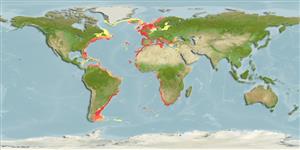Classificação / Names
Common names from other countries
Referência principal
Tamanho / Peso / Idade
Max length : 210 cm TL macho/indeterminado; (Ref. 7251); common length : 80.0 cm TL macho/indeterminado; (Ref. 3397); Peso máx. publicado: 100.0 kg (Ref. 35388)
Length at first maturity
Lm 77.9 range ? - 90 cm
Ambiente
; marinhas demersal; oceanódromo (Ref. 51243); intervalo de profundidade 40 - 600 m (Ref. 7251), usually 100 - 200 m (Ref. 36731)
Clima / Intervalo
Deep-water, preferred 17°C (Ref. 107945); 70°N - 55°S, 82°W - 179°E
Distribuição
Eastern Atlantic: Norway to South Africa (Ref. 6633), including the Mediterranean, Canary Islands, Madeira, Cape Verde, and Tristan da Cunha. Western Atlantic: Newfoundland, Canada and Gulf of Maine to North Carolina, USA (Ref. 7251). Recorded from Uruguay to Argentina (Ref. 9050). Western Indian Ocean: St. Paul and Amsterdam islands (Ref. 6633). Southwest Pacific: New Zealand (Ref. 5755, 9072).
Países | Áreas FAO | Ecossistemas | Ocorrências | Introduções
Descrição breve
Espinhos dorsais (total): 10 - 12; Raios dorsais moles (total): 11-13; Espinhos anais 3; Raios anais moles: 8 - 10. Bluish grey above, paler below with a silvery sheen; fins blackish brown (Ref. 6633). Juveniles have black blotches on head and body (Ref. 6633). Body tall, compressed. Big mouth with big head and a rough bony ridge across upper part of the gill cover (Ref. 35388).
Categoria na Lista Vermelha da IUCN (Ref. 115185)
Ameaça para o homem
Harmless
Utilização humana
Pescarias: pouco comercial; peixe desportivo: sim
Mais informação
ReferênciasAquaculturaPerfil para aquaculturaEstirpesGenéticaFrequência dos alelosHereditariedadeDoençasProcessamentoMass conversion
ColaboradoresFotografiasStamps, CoinsSonsCiguateraVelocidadeTipo de nataçãoÁrea branquialOutras referênciasCérebrosVisão
Ferramentas
Relatórios especiais
Descarregue XML
Fontes da internet
Estimates of some properties based on models
Phylogenetic diversity index
PD50 = 0.8125 many relatives (e.g. carps) 0.5 - 2.0 few relatives (e.g. lungfishes)
Nível Trófico
4.1 ±0.64 se; Based on food items.
Resiliência
Baixo, tempo mínimo de duplicação da população 4,5 - 14 anos (K=0.05-0.08; tmax=76; tm=9-10 yrs estimated from VBGF; Fec=3 million)
Vulnerabilidade
High to very high vulnerability (72 of 100)
Categoria de preço
